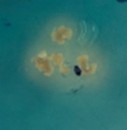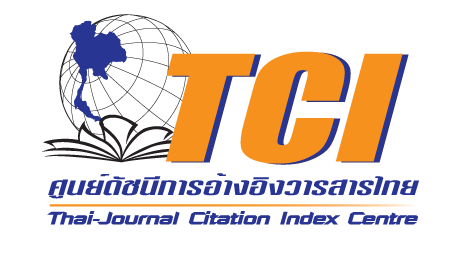Actinomycetes as Effective Biocontrol Agent Against Soft Rot Disease on Choy sum Caused by Erwinia carotovora pv. carotovora
DOI:
https://doi.org/10.53848/ssstj.v12i2.1021Keywords:
Actinomycetes, Erwinia carotovora pv. carotovora, Streptomyces hygroscopicus, Soft rot disease, Biological controlAbstract
Soft rot disease caused by Erwinia carotovora pv. carotovora severely affects Choy sum (Brassica rapa var. parachinensis) production, particularly in tropical regions such as Thailand. Conventional control methods rely heavily on chemical pesticides, raising concerns about environmental sustainability. This study aimed to explore indigenous Actinomycetes from rice field soil in Suphan Buri Province, Thailand, for their potential as biological control agents against soft rot disease and as plant growth promoters. Sixty actinomycete isolates were screened using the agar plug diffusion method, and four isolates (SPB1012, SPB1001, SPB1035, and SPB1022) exhibited significant antagonistic effects against E. carotovora pv. carotovora. Among them, SPB1012 demonstrated the highest inhibitory activity and effectively promoted growth parameters such as shoot height and stem diameter in greenhouse experiments with Choy sum. Molecular characterization revealed 100% sequence similarity between the isolates and Streptomyces hygroscopicus subsp. hygroscopicus NBRC 13472T. These findings suggest that indigenous Actinomycetes from rice fields can serve as promising biocontrol agents for sustainable vegetable production, reducing reliance on chemical pesticides and contributing to environmentally friendly agricultural practices.
References
Alexander, B., Andersen, J. H., Cox, R. P., & Imhoff, J. F. (2002). Phylogeny of green sulfur bacteria on the basis of gene sequences of 16S rRNA and of the Fenna-Matthews-Olson protein. Archives of Microbiology, 178, 131–140. https://doi.org/10.1007/s00203-002-0432-4
Araujo, R., & Ramos, M. A. (2000). Action plan for Margaritifera margaritifera in Europe. Council of Europe.
Balouiri, M., Sadiki, M., & Ibnsouda, S. K. (2016). Methods for in vitro evaluating antimicrobial activity:A review. Journal of Pharmaceutical Analysis, 6(2), 71–79. https://doi.org/10.1016/j.jpha.2015.11.005
Basik, A. A., Juboi, H., Shamsul, S. S. G., Sanglier, J.-J., & Yeo, T. C. (2020). Actinomycetes isolated from wetland and hill paddy during the warm and cool seasons in Sarawak, East Malaysia. Journal of Microbiology, Biotechnology and Food Sciences, 9(4), 774–780.
https://doi.org/10.15414/jmbfs.2020.9.4.774-780
Buensanteai, N., Sompong, M., Saengchan, C., Phansak, P., & Thumanu, K. (2016). PGPR induces resistance against soft rot on Chinese green mustard. Biological and Integrated Control of Plant Pathogens IOBC-WPRS Bulletin, 116, 131–135.
Cao, L., Gao, Y., Yu, J., Niu, S., Zeng, J., Yao, Q., Wang, X., Bu, Z., Xu, T., Liu, X., & Zhu, Y. (2021). Streptomyces hygroscopicus
OsiSh-2-induced mitigation of Fe deficiency in rice plants. Plant Physiology and Biochemistry,158, 275–283.
Cheng, Y.-J., Lee, F.-W., Tsai, Y.-S., & Kuan, Y.-C. (2023). Tanespimycin and rapamycin exhibit antifungal activity against Colletotrichum gloeosporioides and enhance mango resistance to anthracnose via differentially modulating heat shock response. Postharvest Biology and Technology, 204, 112474.https://doi.org/10.1016/j.postharvbio.2023.112474
Cui, W., He, P., Munir, S., He, P., He, Y., Li, X., Yang, L., Wang, B., Wu, Y., & He, P. (2019). Biocontrol of soft rot of Chinese cabbage using an endophytic bacterial strain. Frontiers in Microbiology, 10, 1471. https://doi.org/10.3389/fmicb.2019.01471
Dede, A., Güven, K., & Şahin, N. (2020). Isolation, plant growth-promoting traits, antagonistic effects on clinical and plant pathogenic organisms and identification of actinomycetes from olive rhizosphere. Microbial Pathogenesis, 143,104134. https://doi.org/10.1016/j.micpath.2020.104134
Duncan, D. B. (1955). Multiple range and multiple F tests. Biometrics, 11, 1-42.https://doi.org/10.2307/3001478
Gopalakrishnan, S., Vadlamudi, S., Bandikinda, P., Sathya, A., Vijayabharathi, R., Rupela, O., Kudapa, H., Katta, K., & Varshney, R. K.(2014). Evaluation of Streptomyces strains isolated from herbal vermicompost for their plant growth-promotion traits in rice. Microbiological Research, 169, 40–48. https://doi.org/10.1016/j.micres.2013.09.008
Gratao, P. L., Prasad, M. N. V., Cardoso, P. F., Lea, P. J., & Azevedo, R. A. (2005). Phytoremediation: Green technology for the cleanup of toxic metals in the environment. Brazilian Journal of Plant Physiology, 17(1), 53–64. https://doi.org/10.1590/S1677-04202005000100005
Huse, S. M., Dethlefsen, L., Huber, J. A., Welch, D. M., Relman, D. A., & Sogin, M. L. (2008). Exploring microbial diversity and taxonomy using SSU rRNA hypervariable tag sequencing. PLoS Genetics, 4(11), e1000255.
Janda, J. M., & Abbott, S. L. (2007). 16S rRNA gene sequencing for bacterial identification in the diagnostic laboratory: Pluses, perils, and pitfalls. Journal of Clinical Microbiology, 45(9), 2761–2764.https://doi.org/10.1128/jcm.01228-07
Kampapongsa, D., & Kaewkla, O. (2016). Biodiversity of endophytic actinobacteria from jasmine rice (Oryza sativa L. KDML 105) grown in Roi-Et Province, Thailand and their antimicrobial activity against rice pathogens. Annals of Microbiology, 66, 587–595. https://doi.org/10.1007/s13213-015-1140-z
Kaur, S., Pembleton, L. W., Cogan, N. O., Savin, K. W., Leonforte, T., Paull, J., Materne, M., & Forster, J. W. (2012). Transcriptome sequencing of field pea and faba bean for discovery and validation of SSR genetic markers. BMC Genomics, 13, 104.
Kelley, K. L. (1964). Inter-Society Colour Council-National Bureau of Standard Color name charts illustrated with centroid colours. US Government Printing Office.
Kim, S., Kim, D., Cho, S. W., Kim, J., & Kim, J.-S. (2014). Highly efficient RNA-guided genome editing in human cells via delivery of purified Cas9 ribonucleoproteins. Genome Research, 24(6), 1012–1019.
Kimura, M. (1980). A simple method for estimating evolutionary rate of base substitutions through comparative
studies of nucleotide sequences. Journal of Molecular Evolution, 16, 111–120.
Krewulak, K. D., & Vogel, H. J. (2008). Structural biology of bacterial iron uptake. Biochimica et Biophysica Acta, 1778, 1781–1804. https://doi.org/10.1016/j.bbamem.2007.07.026
Kumar, S., Stecher, G., & Tamura, K. (2016). MEGA7: Molecular Evolutionary Genetics Analysis version 7.0 for bigger datasets. Molecular Biology and Evolution, 33(7), 1870–1874.https://doi.org/10.1093/molbev/msw054
Lorck, H. (1948). Production of hydrocyanic acid by bacteria. Physiologia Plantarum, 1, 142–146.
Ogunmwonyi, I. N., Igbinosa, O. E., Aiyegoro, O. A., & Odjadjare, E. E. (2008). Microbial analysis of different
top soil samples of selected site in Obafemi Awolowo University, Nigeria. Scientific Research and Essay, 3(3), 120–124.
Patten, C. L., & Glick, B. R. (1996). Bacterial biosynthesis of indole-3-acetic acid. Canadian Journal of Microbiology, 42, 207-220.
Phokum, C., Jitareerat, P., Photchanachai, S., & Cheevadhanarak, S. (2006). Detection and classification of soft rot Erwinia of vegetables in Thailand by DNA polymerase chain reaction. Acta Horticulturae, 712, 917-926. https://doi.org/10.17660/ActaHortic.2006.712.121
Pikovskaya, R. I., (1948). Mobilization of phosphorus in soil in connection with the vital activity of some microbial species. Mikrobiologiya, 17, 362–370.
Rattanakavil, T., Kumlung, T., & Klanbut, K. (2020). Isolation and molecular characterization of antifungal production from rice fields rhizosphere soil, Thailand. International Journal of Science and Innovative Technology, 3(1), 41–52.
Salem, E. A., & Abd El-Shafea, Y. M. (2018). Biological control of potato soft rot caused by Erwinia carotovora subsp. carotovora. Egyptian Journal of Biological Pest Control, 28, 94. https://doi.org/10.1186/s41938-018-0100-x
Schwyn, B., & Neilands, J. B. (1987). Universal chemical assay for the detection and determination of siderophores. Analytical Biochemistry, 160, 47–56.
Stackebrandt, E., & Ebers, J. (2006). Taxonomic parameters revisited: Tarnished gold standards. Microbiology Today, 33, 152–155.
Stackebrandt, E., & Goebel, B. M. (1994). Taxonomic note: A place for DNA-DNA reassociation and 16S rRNA
sequence analysis in the present species definition in bacteriology. International Journal of Systematic Bacteriology, 44(4), 846–849.
Takizawa, M., Colwell, R. R., & Hill, R. T. (1993). Isolation and diversity of actinomycetes in the Chesapeake Bay. Applied and Environmental Microbiology, 59(4), 997–1002. https://doi.org/10.1128/aem.59.4.997-1002.1993
Tsuda, K., Tsuji, G., Higashiyama, M., Ogiyama, H., Umemura, K., Mitomi, M., Kubo, Y., & Kosaka, Y. (2016). Biological control of bacterial soft rot in Chinese cabbage by Lactobacillus plantarum strain BY under field conditions. Biological Control, 100, 63–69. https://doi.org/10.1016/j.biocontrol.2016.05.010
Waksman, S. A. (1961). The Actinomycetes: Vol. II. Classification, identification and description of genera and species.The Williams and Wilkins.
Xu, T., Cao, L., Zeng, J., Franco, C. M. M., Yang, Y., Hu, X., Liu, Y., Wang, X., Gao, Y., Bu, Z., Shi, L., Zhou, G., Zhou, Q., Liu, X., & Zhu, Y. (2019). The antifungal action mode of the rice endophyte Streptomyces hygroscopicus OsiSh-2 as a potential biocontrol agent against the rice blast pathogen. Pesticide Biochemistry and Physiology, 160, 58–69. https://doi.org/10.1016/j.pestbp.2019.06.015
Yukphan, P., Malimas, T., Potacharoen, W., Tanasupawat, S., Tanticharoen, M., & Yamada, Y. (2005). Neoasaia
chiangmaiensis gen. nov., sp. nov., a novel osmotolerant acetic acid bacterium in the α-Proteobacteria. The Journal of General and Applied Microbiology, 51, 301–311.
Zhang, J., & Zhang, L. (2011). Improvement of an isolation medium for actinomycetes. Modern Applied Science,
(2), 124–127.

Downloads
Published
How to Cite
Issue
Section
License
Copyright (c) 2025 Suan Sunandha Rajabhat University

This work is licensed under a Creative Commons Attribution 4.0 International License.











